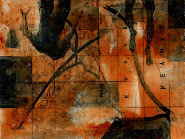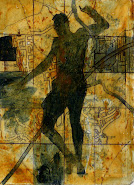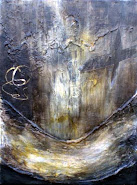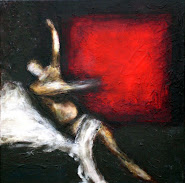There are a few issues which I have been meaning to explore in written form for a good few months. Exams, laziness, change and confusion have all meant I have yet to get around to articulating them. They are concerned with quite specific painterly notions I am keen to deal with. The semiotics of the medium, its history and its relevance to 21st century practise; most concerned with paint as a sign with mimetic, self referential, symbolic, expressive and musical signification. I am also keen to get into writing some thoughts on space, again as a semantic tool, with a multiplicity of dimensions. On top of this an interest in two fold-ness as something all painters have been interested in is something I want to look at. I say all this because I feel a need to remind myself of what it is I want to consider for fear of forgetting. I hope to get some notes out here on the above issues very soon.
It brings me onto the fact, however, that I have some issues which I have just considered, which I am going to tackle now. Whilst they are fresher, more generalised and less important I feel I can just splurt them out without so much worry. Hopefully it will staert to jog my mind and writing back into action for above mentioned posts.
Andy’s post, two below, made me think about the point of painting. In particular I’m interested in the lessons to be learned from Modernism (that strands of Modernism caught up with Greenberg’s ideals and pervaded in the work of the 20th Century abstract painters)
Despite much ‘progress’ since the 1960’s the peak of ‘high Modernism’ is still the visual and philosophical starting point of most young people, like myself, with pretensions to become ‘painters’. It is fashionable to idolise Greenberg first and then to laugh over his Imperialist idealism later. Both these polemical stances don’t get to the crux of the matter. What did that period of painting tell us.
Greenberg’s artificial narrative was a necessary call to arms. He made painters realise that to move on we needed to focus our attention on paintings independent properties. Thus a growing obsession with the surface and flatness developed. What Greenebrg realised was that to develop painters needed to question paintings very nature of being. It was an ontological inward looking dispute. Ironically, however, the painters who triumphed were those who in looking to the specifics of the medium started to challenge the nature of being in general. Rothko’s canvases. They pulsate, great vacuous expanses throbbing in front of our eyes. To cast them off as mere plays on formal values is ludicrous. Within the shifting layers lies, as Andy said the timeless and the tragic, the core essentials of humanity seem to vibrate in front of our eyes. These are, of course, highly unfashionable statements. But merely ‘experience’ one of his best paintings and it is clearly true. Where Modernism fails is when painting becomes a closed door, where in questioning itself it seems to look literally no further than the edges of the canvas. It’s a self loving, elitist, indulgent and, ultimately boring pursuit.
Which brings me to painting today. We need to learn from the success of a Rothko or A Pollock. In looking forward we need to search for something beyond mere quick fix decoration, cheap sensations and skin deep beauty. We need to harness paint and use it to continue to explore its limits and its potential to deal with bigger issues. Which brings me neatly to another point. Is this not what painters of any note have always tried to do? Obviously only really good painters can do it. But have not all painters been concerned with that symbiotic duality, to extend the knowledge of the medium and the mediums ability to articulate notions beyond itself. So concerned are we with progress, with a linear history, with evolution that we forget that many things don’t change. Painting is the placing of a coloured fluid onto a two dimensional support. We can theorise all we like but however much history passes between us that means a painter today is as united to Apelles as Veronesse was to Titian. If modern Physics has taught us anything is it not to realise that all notions of time are constructed. Can we not apply this to painting and instead of seeing the past as an ordered ladder see it as one continuous whole, from which we feed? With a continued obsession with sociological and contextual research I doubt this will happen. We will continue to feel a need to locate and justify painting in regards to its specific time. Yet we should not be surprised. Lucky the potential painter can ignore all this academic crap.
Our Artwork
Subscribe to:
Post Comments (Atom)




































No comments:
Post a Comment